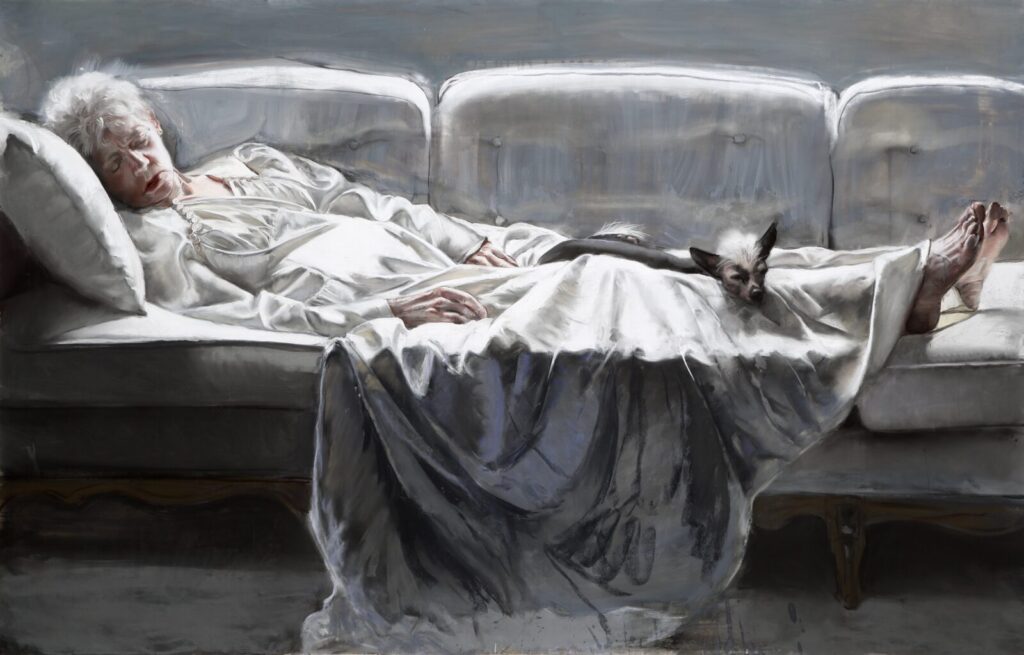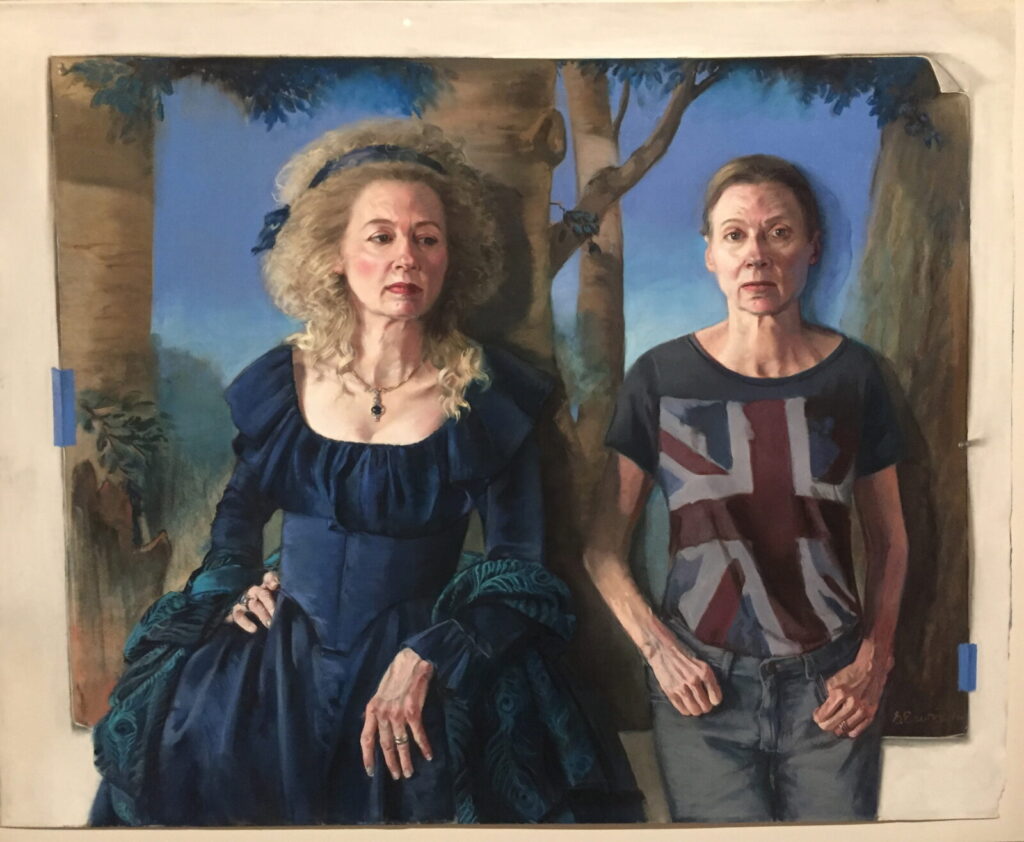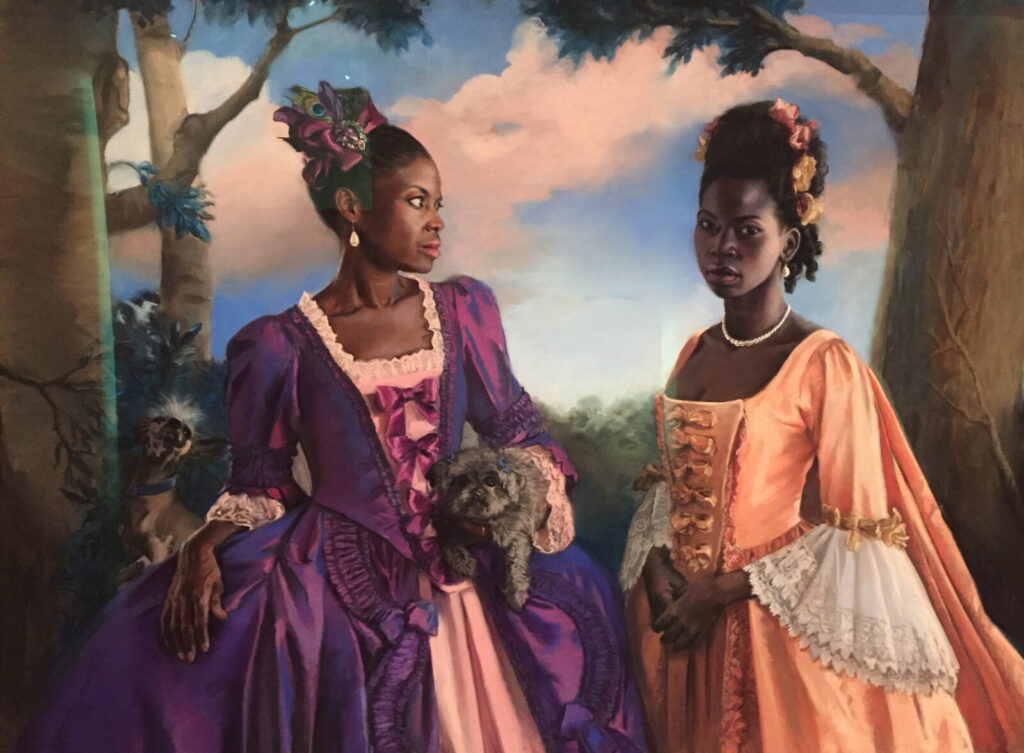Gaela Erwin: Reframing the Past is on view at the Speed Art Museum through October 30th. It complements an earlier art exhibition, Gaela Erwin: Mother that was on view at the University of Louisville’s Cressman Center for the Visual Arts this past summer.
In each show Erwin explores her genealogy, both familial and artistic. The German Expressionist Max Beckmann wrote in 1939, “the self is the greatest mystery in the world.” Like Beckmann’s pursuit of “the mystery of being,” Erwin’s art may be seen as a continual effort to be ever more specific about the psychology of identity, household relationships and art historical heritage. The family portraits are less about lineage and more about penetrating self-discovery. The artist is not leaning on art historical models for legitimation or prestige, but to delve deeply into the nature of portraiture in past and present practice.

Erwin’s greatest invention in the Cressman show was to depict her nonagenarian mother asleep, reclining full length, attired in her wedding dress. Erwin’s mother (now deceased) suffered from dementia and Erwin’s use of her mother as a subject ironically presents a gifted physiognomist contemplating a loved one subtly expressionless. The bridal gown unfamiliarizes the sitter: dress-up is a way of losing touch with time, and heightening, in this case, the struggle of age versus beauty.
In her affecting portrayals of the last years of her mother’s life, Erwin conveys a telling inventory of the symptoms of dementia evoked in John Bayley’s phrases describing his wife, Iris Murdoch: “behindhand;” “unreassured;” “wonder on the edge of fear;” “the daily pucker of blank anxiety.” Erwin charts her mother’s mien, the dropping lower lip, the sagging flesh, and the bulging carotid artery, yet also intimates empathy for a striking woman seemingly accustomed to being beautiful, the chalk uncannily taking on the substance of rouge and lipstick. The pastel is handled very directly in this work and left unblended as in the bold red and black marks defining the arthritic fingers of the sitter’s right hand.
Several double portraits of Erwin and her sister Shelley were in both exhibitions. Especially in the costumed double portraits in the Speed show, the artist intimates the complexity of sibling relationships and the numbing exhaustion of negotiating the care of a dying parent. In The Erwin Sisters as Artist and Poet compressing the figures against the frontal plane signals both closeness and discomfort. Nonetheless, the recurring portraits in 18th and 19th Century costume create an air of politesse, courtly manners and courtesies, as if these traditions offered a pathway to an authentically civil society.

An extension of the portraits with her sister is Erwin’s Self Portrait as Twins Separated at Birth. The backdrop of trees adapted from Francis Cotes in four works is here rendered a trompe l’oeil picture within a picture held on the wall behind the double portrait with push pins and masking tape. The finesse with which the sheen of blue satin is rendered in the 18th Century Erwin, on the left, contrasts with the abstract expressionist gestural drawing describing the faded Union Jack t-shirt in the contemporary Erwin on the right.
The gaze of the informal, t-shirted and blue-jeaned self is direct and confrontational, while the historicized figure averts from looking at the viewer. A traditional symbol of vanity, a peacock feather, adorns the shawl draped over the arms of the costumed version. The constricted period gown and blonde wig gives the fictional character an air of hauteur, dominating the sister two centuries her junior. A literal depiction of the idiom denoting worry and anxiety, “ I am beside myself,†is given a narrative cast. As in many other works in the exhibition, there is a sense of incipient action – the moment before the moment something momentous will happen, perhaps when artifice is revealed and the real Gaela Erwin steps forward.
In the catalogue to the exhibition, Eileen Yanoviak, Exhibition Coordinator at the Speed Art Museum, places Erwin’s portraits firmly in the tradition of the fantasy portrait, with its openings to associations and fictions about the past:Â “They are a sort of ‘self-fashioning’ through history, a way to select those attributes and narratives that define an individual. Removed from contemporary reality, these portraits seem to reveal the paradoxes and complexities of the present through the past.”
Erwin pays homage to pastel practice with riffs on studies by 18th Century masters in the Speed’s collection by Jean-Baptiste Perroneau (1715-1783), and Francis Cotes ( 1726-1770), as well as the 20th Century artist, Winold Reiss (1786-1953).

The exhibition’s tour-de-force is a double portrait of Licia Priest and Neema Tambo modeled on the Francis Cotes depiction of two young women. The African-American subjects are resplendent in 18th Century costume: Erwin’s pastel is more finished in these likenesses than in other works in the show and Priest and Tambo occupy a more ample field. Erwin deploys her technical skills to provide a convincing case for the dignity and self-possession of the sitters. Yanoviak notes, accurately, that they are “aggressively present.” The fantasy of elegant, aristocratic black women in 18th Century high fashion garb engenders a back-and-forth meditation on sexual and racial politics in the 18th Century and today. Staging does not constrict the figures or indulge an inveigling flattery but instead re-doubles ironic reverberations between person and persona, actor and role. Like a great evening of theater, the performers seem totally believable, the artificiality and glitz of setting and costume enhancing rather than detracting from the illusion.
The Speed needs to be applauded for a very full presentation of a Kentucky artist with an excellent illustrated catalogue. Also notable is the juxtaposition of historical works from the permanent collection and contemporary responses. For all art museums, the holy grails of relevance and accessibility are elusive - Gaela Erwin: Reframing the Past sets a high and imitable standard.




